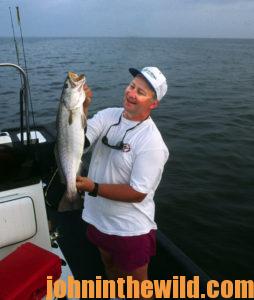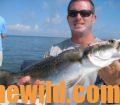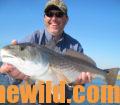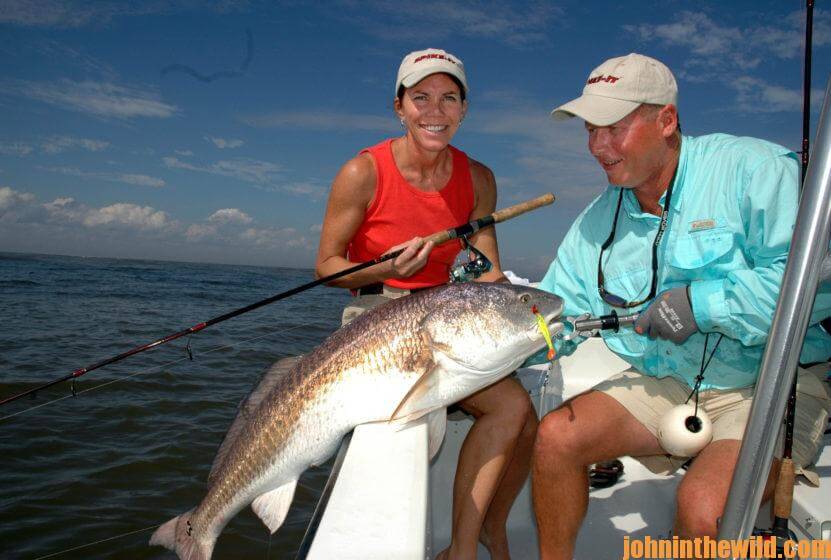Editor’s Note: With many school systems pushing back the start of school in 2020, and with many schools holding virtual classrooms, families are headed to the Gulf of Mexico to enjoy the sand, the water and the fishing. Here are some ideas for productive inshore and offshore fishing.
The speckled trout wouldn’t bite anyone’s lines. None of the oyster reefs, deep-hole channels or traditional trout haunts produced at the time my brother, my dad and myself went on our annual trout-fishing trip. Many anglers congregated at the marina that day, frustrated that no one could catch any fish. On the second day of our trip, the two men still had taken no fish by 11:00 am.
On the way back to the marina in our boat, my brother Archie decided to let-out the line on his spinning reel about 500-yards from the dock to try and get a twist out of his line. He still had on a lead-headed jig with a chartreuse grub tied to the line. Once he’d engaged the reel and gone no more than 30 yards, he felt a violent strike on his rod. “Slow the boat down, Pop. I’ve got a fish!” said my brother. In disbelief, my father responded to my brother’s excitement and slowed-down the boat. A fat 3-pound speckled trout came to the boat.
“Since you caught that fish trolling,” Pop said, “Let’s troll these grubs along this little channel that leads to the marina and see what happens.” As our rods bent, and our drags screamed, we forgot about lunch. In those days, speckled trout had a limit of 50, and we produced our limit just before dark. Before other fishermen began to come in to the marina, we had our trout in the cooler.
Back at the marina, we began the 2-hour job of filleting, washing and packaging our catch. A crowd soon gathered at the fish-cleaning table. Everyone wanted to know where these lucky anglers had caught all their fish. “The majority of the fish came from Buoy 97,” Dad lied with the mastery of a veteran angler. “You need to get out there just as the sun rises. The fish bite periodically throughout the day.” The next morning before daylight, outboards cranked-up with anglers headed to the farthest buoy from the marina. At about 8:00 am, we returned to the water within sight of the marina, trolling our chartreuse grubs. Long before other fishermen came in at the end of the day, we had cleaned and packed two more limits of trout and headed back home.
You’ll find trolling the quickest, easiest, surest way to pinpoint fish, regardless of water and weather conditions. An old-timer once told me, “Fish have fins, and they swim around every day. To consistently catch them, you’ve got to find them. There’s no quicker way to locate fish than by trolling.” Trolling not only produces inshore species like speckled trout and redfish but also allows you to take fish out in the Gulf of Mexico using this tactic.
Strategy for Reds:
The universally-accepted tactic for catching redfish uses planers and spoons to troll shallow water. I never have seen a saltwater place where you can’t troll a gold spoon on a downrigger close to the bottom and catch big redfish. From Texas to Florida, serious red fishermen know you can cover more water and catch more fish by trolling a gold spoon. Although many anglers use this tactic to catch reds, more fishermen use this trolling technique to locate schools of redfish. Once they locate the schools, they’ll hold their boats in that area and often fish with jigs, dead bait or live bait to continue catching redfish from the school they’ve located by trolling.
King Mackerel and Spanish Mackerel:
Inshore and offshore fishermen enjoy trolling for mackerel. “I like to troll for king and Spanish mackerel, because we usually catch something every time we go out,” the late Bill Ethridge, a longtime avid Alabama angler who fished Alabama’s Gulf Coast, told me. “I love to see fishermen’s rods bend when they get nice-sized fish on their lines.”
T o catch mackerel, Ethridge fished a No. 1 or a No. 2 Halco spoon (https://www.halcotackle.com/). He tied the spoon to 20 feet of 80-pound-test monofilament leader attached to a planer. When Ethridge fished a No. 1 spoon, he tied the leader to a No. 2 planer. When he fished a No. 2 spoon, he used a No. 3 planer. The No. 2 planer would take his spoon down to 8 to 10 feet, while the No. 2 planer kept his bait at 6 to 8 feet. “I found I take more mackerel using this planer and spoon rig than I do with any-other technique I’ve tried,” Ethridge said.
o catch mackerel, Ethridge fished a No. 1 or a No. 2 Halco spoon (https://www.halcotackle.com/). He tied the spoon to 20 feet of 80-pound-test monofilament leader attached to a planer. When Ethridge fished a No. 1 spoon, he tied the leader to a No. 2 planer. When he fished a No. 2 spoon, he used a No. 3 planer. The No. 2 planer would take his spoon down to 8 to 10 feet, while the No. 2 planer kept his bait at 6 to 8 feet. “I found I take more mackerel using this planer and spoon rig than I do with any-other technique I’ve tried,” Ethridge said.
Ethridge also carefully chose the color of his spoons with his two favorite colors being chartreuse and pink. “Until the middle of summer, the pink-colored spoon seems to work best for trolling for mackerel,” Ethridge explained. “But then from August until the fall, I seem to catch more fish on the chartreuse spoon.” At the end of the season if the mackerel didn’t take the spoons, Ethridge changed to a Sea Witch duster (https://jmtackle.com/collections/dusters) with a strip of bonito trailer to catch the tentative mackerel. Although many anglers would attach a 6-inch piece of wire to the last hook on the lure and secure a second set of treble hooks on the end of that leader to catch mackerel that attacked the bait from the side, Ethridge never believed he needed that second stinger hook.
Often an angler who trolls for mackerel using spoons and planers makes the mistake of trying to set the hook when he takes the rod out of the rod holder. However, when a mackerel takes a spoon trolled behind a boat, you’ll know you’ve hooked the fish when the rod begins to bend. If you jerk back on the rod and try to set the hook harder, you often will tear a hole in the mackerel’s mouth, which can cause the hook to fall out, if the line has any slack during the battle to the boat. “If a mackerel takes a spoon, simply pick up your rod, and begin to wind,” Ethridge said. “Don’t pump and wind like a marlin fisherman does. Just reel the fish in slowly and steadily to get it to the side of the boat. If you’ll apply constant pressure and not give the fish any slack, your chances for boating that fish, whether a king or a Spanish mackerel, will increase by 200 percent.”
Captain Kathy Broughton of the “Kitty Wake” enjoys trolling for Spanish mackerel. “As the water starts to warm-up in March and then through the summer, we’ll see flocks of seagulls and terns diving on bait. Under those birds, you may find a school of Spanish mackerel making an early run. We catch the Spanish mackerel on a Got-Cha gold or silver spoon (http://www.seastriker.com/styled-17/index.html). You can troll for them with a No. 1 planer with 40-50-pound-test monofilament leader and a Clarkspoon (https://clarkspoon.com/) or a small Drone spoon (http://www.dronespoons.com/), either in chartreuse or pink colors. I prefer using monofilament rather than wire leader, because I know I get more strikes and catch more fish on monofilament, even though every now and then a Spanish mackerel may cut that monofilament with its sharp teeth.”
See how Captain Broughton fishes and what she catches: http://youtu.be/njismbL7u6A. To fish with Captain Kathy Broughton, call 251-981-4044, or email kittywakecharters@yahoo.com, or visit https://www.zekeslanding.com/yacht_charters/kittywake/.
Big Kings:
 I have a friend who fishes in the Southern Kingfish Association (SKA) tournaments (https://fishska.com/) held throughout the South. He fishes for really-big kings and often will run 100 miles or more in one day to get to a gas rig, an oil rig or some other type of structure he feels will hold big king mackerel. To find-out quickly if any king mackerel hold at a particular wreck, rig or reef, my buddy begins to troll slowly with a dead ribbonfish for bait. “For the main line, I’ll use 25-pound test line,” he explains. “Back at the main line, I’ll tie-on a No. 10 barrel swivel to which I’ll attach a piece of 40-pound-test piano wire. I’ll put on a No. 1/0 hook at the end of the line. To the shank of the hook, I’ll attach another 2-1/2-feet of wire, and on that piece of wire I’ll place four strong No. 4 treble hooks that will allow three of those hooks to slide up and down the wire. I’ll attach the fourth hook to the end of the wire. By using the three sliding hooks and the one attached hook, I can rig a ribbonfish twice as fast as I can if all of the hooks have to be tied or wired onto the leader. The ribbonfish lets me know if kings are holding around the structure I’ve chosen.”
I have a friend who fishes in the Southern Kingfish Association (SKA) tournaments (https://fishska.com/) held throughout the South. He fishes for really-big kings and often will run 100 miles or more in one day to get to a gas rig, an oil rig or some other type of structure he feels will hold big king mackerel. To find-out quickly if any king mackerel hold at a particular wreck, rig or reef, my buddy begins to troll slowly with a dead ribbonfish for bait. “For the main line, I’ll use 25-pound test line,” he explains. “Back at the main line, I’ll tie-on a No. 10 barrel swivel to which I’ll attach a piece of 40-pound-test piano wire. I’ll put on a No. 1/0 hook at the end of the line. To the shank of the hook, I’ll attach another 2-1/2-feet of wire, and on that piece of wire I’ll place four strong No. 4 treble hooks that will allow three of those hooks to slide up and down the wire. I’ll attach the fourth hook to the end of the wire. By using the three sliding hooks and the one attached hook, I can rig a ribbonfish twice as fast as I can if all of the hooks have to be tied or wired onto the leader. The ribbonfish lets me know if kings are holding around the structure I’ve chosen.”
My fishing friend uses another tactic to check a structure for big king mackerel. He cuts the fins off the dead ribbonfish to keep the ribbonfish from spinning behind the boat. “The kings won’t hit a bait that’s spinning,” he says. He’ll also troll live blue runners on 10 feet of blue monofilament coming off a planer when he fishes for big kings. “If I fish over a 100-foot bottom, I’ll put a blue runner down at 50 feet,” he says. “I’ll troll a second blue runner at 25 feet, and the third blue runner I’ll troll 1 or 2 feet below the surface.” He calls his blue runners the rabbits of the sea, because he believes all the prey fish, especially the king mackerel, like to catch and eat the blue runner. When trolling for the king mackerel with the blue runner, he often will catch cobia, big snapper and/or grouper.
To catch more fish the next time you go to the Gulf of Mexico near shore, try one of these trolling strategies to have more bent rods and more fillets for your skillet.
To learn more about saltwater fishing, check out John E. Phi llips’ book, “Alabama’s Inshore Saltwater Fishing: A Year-Round Guide for Catching More Than 15 Species” at http://amzn.to/11dJhN7. If necessary, copy and paste the link into your browser.
Tomorrow: Use Live Bait for Speckled Trout and Redfish










